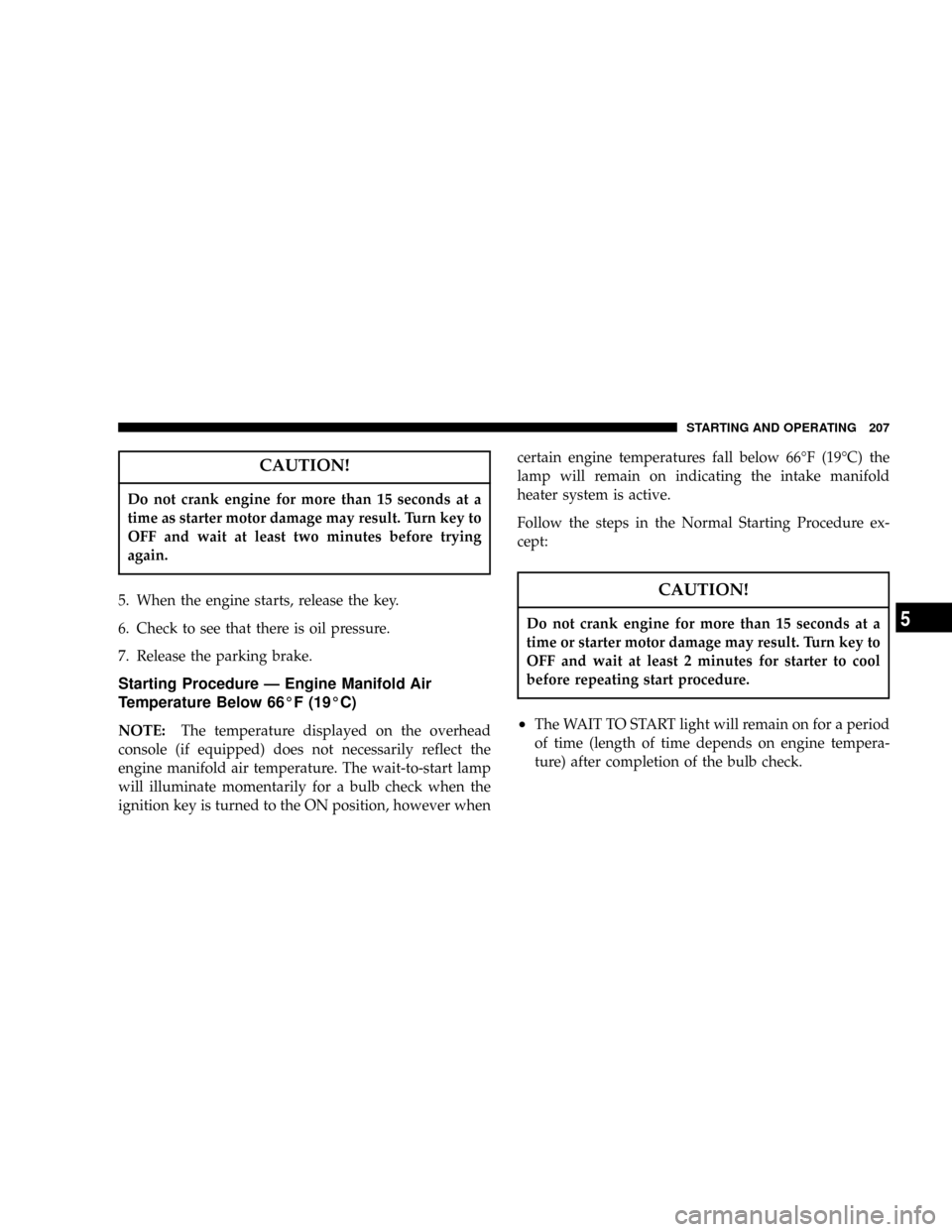Page 6 of 426

VAN CONVERSIONS/CAMPERS
The Manufacturer's Warranty does not apply to body
modifications or special equipment installed by van
conversion/camper manufacturers/ body builders. Such
equipment includes video monitors, VCRs, heaters,
stoves, refrigerators, etc. For warranty coverage and
service on these items, contact the applicable manufac-
turer.
Operating instructions for the special equipment in-
stalled by the conversion/camper manufacturer should
also be supplied with your vehicle. If these instructions
are missing, please contact your selling dealer for assis-
tance in obtaining replacement documents from the
applicable manufacturer.
VEHICLE IDENTIFICATION NUMBER
The vehicle identification number (VIN) is found on a
stamped plate located on the left front corner of the
instrument panel pad, visible from outside of the vehicle
through the windshield. This number also appears on the
Automobile Information Disclosure Label affixed to a
window on your vehicle. Save this label for a convenient
record of your vehicle identification number and optional
equipment.
6 INTRODUCTION
Page 140 of 426
mRemote Sound System Controls Ð If Equipped . . 181
NRadio Operation......................182
NTape Player.........................182
NCD Player..........................182
mCassette Tape And Player Maintenance.......183
mCompact Disc Maintenance................184
mRadio Operation And Cellular Phones........184
mClimate Controls.......................185NHeater Only Ð Fleet Vehicles.............185
NAir ConditioningÐIf Equipped...........187
NElectric Rear Window Defroster And Heated
Sideview Mirrors Ð If Equipped..........191
NAir Conditioning With Dual Zone Temperature
Control Ð If Equipped.................191
NOperating Tips.......................196
NOperating Tips Chart...................198
140 UNDERSTANDING YOUR INSTRUMENT PANEL
Page 185 of 426
CLIMATE CONTROLS
The controls for the heating and ventilation system in this
vehicle consist of a series of rotary knobs. These comfort
controls can be set to obtain desired interior conditions.
Heater Only Ð Fleet Vehicles
The mode control (at the right of the
control panel) can be set in any of the
following positions:
UNDERSTANDING YOUR INSTRUMENT PANEL 185
4
Page 205 of 426

ACC
Allows the electrical accessories to be used when the
engine is not running.
Manual Transmission Key Release Button
To remove the key on vehicles equipped with manual
transmissions, turn the key to the Lock position and press
the button to remove the ignition key.
Key Reminder
An alarm will sound to remind you if the key is left in the
ignition and the driver's door is opened.
STARTING PROCEDURES
The Cummins Diesel engine is equipped with several
features designed to assist cold weather starting and
operation:
²The engine block heater is a resistance heater installed
in the water jacket of the engine just above and behind
the oil filter. It requires a 110±115 volt AC electrical
outlet with a grounded, three-wire extension cord.
NOTE:The engine block heater cord is a factory in-
stalled option. If your vehicle is not equipped, heater
cords are available from your authorized Mopartdealer.
²A 12±volt heater built into the fuel filter housing aids
in preventing fuel gelling. It is controlled by a built-in
thermostat.
STARTING AND OPERATING 205
5
Page 207 of 426

CAUTION!
Do not crank engine for more than 15 seconds at a
time as starter motor damage may result. Turn key to
OFF and wait at least two minutes before trying
again.
5. When the engine starts, release the key.
6. Check to see that there is oil pressure.
7. Release the parking brake.
Starting Procedure Ð Engine Manifold Air
Temperature Below 66ÉF (19ÉC)
NOTE:The temperature displayed on the overhead
console (if equipped) does not necessarily reflect the
engine manifold air temperature. The wait-to-start lamp
will illuminate momentarily for a bulb check when the
ignition key is turned to the ON position, however whencertain engine temperatures fall below 66ÉF (19ÉC) the
lamp will remain on indicating the intake manifold
heater system is active.
Follow the steps in the Normal Starting Procedure ex-
cept:
CAUTION!
Do not crank engine for more than 15 seconds at a
time or starter motor damage may result. Turn key to
OFF and wait at least 2 minutes for starter to cool
before repeating start procedure.
²The WAIT TO START light will remain on for a period
of time (length of time depends on engine tempera-
ture) after completion of the bulb check.
STARTING AND OPERATING 207
5
Page 208 of 426

²After the WAIT TO START light goes off, turn the
ignition key to START. Do not press the accelerator
during starting.
²Check to see that there is oil pressure.
²Allow the engine to idle at fast idle for about three
minutes until the manifold heaters have completed
the post-heat cycle.
²Release the parking brake and drive.
NOTE:Engine idle speed will automatically increase to
1000 rpm at low coolant temperatures to improve engine
warm-up.
NOTE:If the engine stalls or if the ignition switch is left
On for more than 2 minutes after the WAIT TO START
light goes out, reset the grid heaters by turning the
ignition switch to Off and the back On. Repeat steps 3
through 7 of the normal starting procedure.
For Extremely Cold Weather Starting (Engine
Temperature Below 0ÉF (- 18ÉC)
In extremely cold weather below 0ÉF (- 18ÉC) it may be
beneficial to cycle the manifold heaters twice before
attempting to start the engine. This can be accomplished
by turning the ignition OFF and then back ON after the
WAIT TO START light has gone off, but before the engine
is started. However, repeated cycling of the manifold
heaters will result in damage to the heater elements or
reduced battery voltage.
NOTE: If multiple pre-heat cycles are used before
starting, additional engine run time may be required to
maintain battery state of charge at a satisfactory level.
²If the engine stalls after the initial start, the ignition
must be turned to the OFF position and then to the ON
position to recycle the manifold heaters.
NOTE:Excessive white smoke and poor engine perfor-
mance will result if manifold heaters are not recycled.
208 STARTING AND OPERATING
Page 209 of 426

²Heat generated by the manifold heaters dissipates
rapidly in a cold engine. If more than two minutes
pass between the time the WAIT TO START light goes
OFF and the engine is started, recycle the manifold
heaters by turning the ignition OFF and then back ON.
²If the vehicle is driven and vehicle speed exceeds 18
mph (29 km) before the manifold heater post-heat
(after start) cycle is complete, the manifold heaters will
shut off.
²If the engine is started before the WAIT TO START
light turns off, the preheat cycle will turn off.
²If the engine is cranked for more than 10 seconds, the
post-heat cycle will turn off.
NOTE:Engine idle speed will automatically increase to
1000 rpm at low coolant temperatures to improve engine
warm-up.NOTE:When a diesel engine is allowed to run out of
fuel or the fuel gels at low temperatures, air is pulled into
the fuel system.
You may try priming as described below.
1. Add a substantial quantity of fuel to the tank (5 to 10
gallons) or eliminate the gelled fuel condition.
2. Crank the engine for 1 to 2 seconds. If the engine does
not start, then release the key or starter button back to the
RUN position (do not turn the key back to the OFF
position). The electric fuel transfer pump will continue to
run and purge air from the system for about 25 seconds.
After 25 seconds, attempt to start the engine again.
3. Start the engine using the Normal Starting Procedure.
4. Repeat the procedure if the engine does not start.
STARTING AND OPERATING 209
5
Page 211 of 426

WARNING!
Do not leave children or animals inside parked
vehicles in hot weather. Interior heat build up may
cause serious injury or death.
NORMAL OPERATION
Observe the following when the engine is operating.
²All message center lights are off.
²Check Engine Lamp is off.
²Engine Oil Pressure is above 10 psi (69 kPa) at idle.
²Low Oil Pressure light is off.
²Voltmeter Operation:
²The voltmeter may show a gauge fluctuation if
certain engine temperatures are below 66ÉF (19ÉC).
This cycling operation is caused by the post-heatcycle of the intake manifold heater system. The
number of cycles and the length of the cycling
operation is controlled by the engine control mod-
ule, this time will not exceed 150 seconds. The
needle should then stabilize at the approximate
operation point.
²The cycling action will cause temporary dimming of
the headlamps, interior lamps, and also a noticeable
reduction in blower motor speed.
Cold Weather Precautions
Operation in ambient temperature below 32ÉF (0ÉC) may
require special considerations. The following charts sug-
gest these options:
STARTING AND OPERATING 211
5